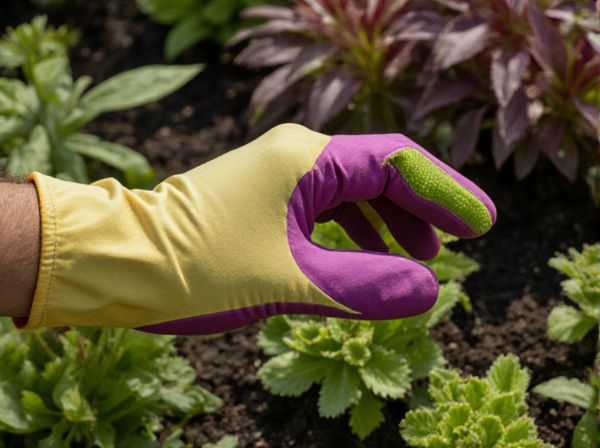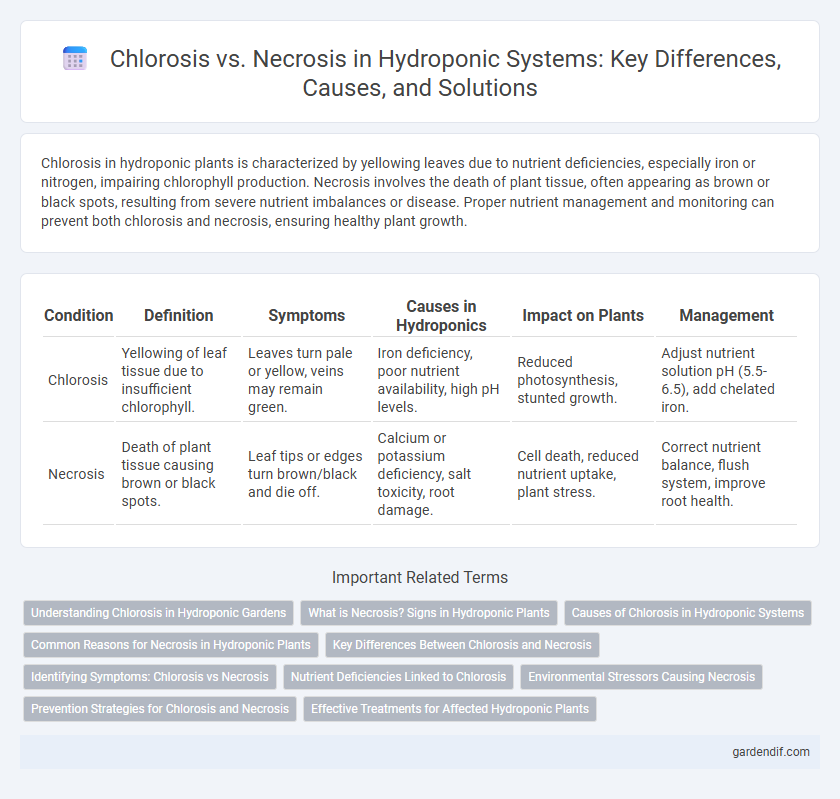
Chlorosis vs Necrosis Illustration
Chlorosis in hydroponic plants is characterized by yellowing leaves due to nutrient deficiencies, especially iron or nitrogen, impairing chlorophyll production. Necrosis involves the death of plant tissue, often appearing as brown or black spots, resulting from severe nutrient imbalances or disease. Proper nutrient management and monitoring can prevent both chlorosis and necrosis, ensuring healthy plant growth.
Table of Comparison
| Condition | Definition | Symptoms | Causes in Hydroponics | Impact on Plants | Management |
|---|---|---|---|---|---|
| Chlorosis | Yellowing of leaf tissue due to insufficient chlorophyll. | Leaves turn pale or yellow, veins may remain green. | Iron deficiency, poor nutrient availability, high pH levels. | Reduced photosynthesis, stunted growth. | Adjust nutrient solution pH (5.5-6.5), add chelated iron. |
| Necrosis | Death of plant tissue causing brown or black spots. | Leaf tips or edges turn brown/black and die off. | Calcium or potassium deficiency, salt toxicity, root damage. | Cell death, reduced nutrient uptake, plant stress. | Correct nutrient balance, flush system, improve root health. |
Understanding Chlorosis in Hydroponic Gardens
Chlorosis in hydroponic gardens manifests as yellowing leaves caused by nutrient deficiencies, particularly iron, magnesium, or nitrogen imbalances that disrupt chlorophyll production. This condition reduces photosynthesis efficiency, leading to stunted plant growth and diminished yield. Identifying chlorosis early allows for precise nutrient adjustments and pH control, crucial for maintaining optimal plant health in hydroponic systems.
What is Necrosis? Signs in Hydroponic Plants
Necrosis in hydroponic plants refers to the death of tissue, often caused by nutrient deficiencies, disease, or environmental stress. Signs of necrosis include brown or black dead patches on leaves, starting at the edges or tips and spreading inward. These symptoms indicate severe damage requiring immediate adjustment of nutrient levels, pH balance, or pest management to prevent crop loss.
Causes of Chlorosis in Hydroponic Systems
Chlorosis in hydroponic systems primarily results from nutrient deficiencies, particularly iron, magnesium, and nitrogen, which are crucial for chlorophyll synthesis. Poor water quality, high pH levels, and improper nutrient solution formulation can inhibit nutrient uptake, leading to yellowing leaves. Root damage caused by oxygen deprivation or pathogen infection further exacerbates chlorosis by limiting nutrient absorption in hydroponic plants.
Common Reasons for Necrosis in Hydroponic Plants
Common reasons for necrosis in hydroponic plants include nutrient imbalances such as potassium or calcium deficiencies, salt buildup leading to root damage, and improper pH levels that hinder nutrient uptake. Environmental stressors like inadequate oxygenation in the nutrient solution and temperature extremes also contribute significantly to tissue death. Monitoring nutrient concentrations and maintaining optimal growing conditions are essential to prevent necrosis and ensure healthy plant development.
Key Differences Between Chlorosis and Necrosis
Chlorosis in hydroponic plants is characterized by yellowing leaves due to insufficient chlorophyll production, often caused by nutrient deficiencies such as iron or nitrogen. Necrosis refers to the death of plant tissue, resulting in brown, dry, and brittle areas typically triggered by severe nutrient imbalances, diseases, or environmental stress. Key differences include chlorosis affecting leaf color primarily without tissue death, while necrosis involves irreversible tissue damage and decay.
Identifying Symptoms: Chlorosis vs Necrosis
Chlorosis in hydroponic plants is characterized by yellowing leaves due to insufficient chlorophyll production, often caused by nutrient deficiencies such as iron or magnesium. Necrosis manifests as dead or brown patches on leaves, indicating tissue death frequently resulting from severe nutrient imbalances or toxic conditions. Accurate identification of chlorosis versus necrosis symptoms is crucial for adjusting nutrient solutions and preventing further plant stress in hydroponic systems.
Nutrient Deficiencies Linked to Chlorosis
Chlorosis in hydroponic systems often indicates nutrient deficiencies, particularly a lack of iron, magnesium, or nitrogen, which are essential for chlorophyll production. Iron deficiency causes interveinal chlorosis, while magnesium deficiency results in yellowing between leaf veins, and nitrogen deficiency leads to general leaf yellowing. Understanding these nutrient imbalances is crucial to preventing chlorosis and maintaining healthy, vibrant plants in hydroponic setups.
Environmental Stressors Causing Necrosis
Environmental stressors causing necrosis in hydroponic systems include extreme temperature fluctuations, excessive salinity, and prolonged waterlogging, which disrupt cellular function and lead to tissue death. Insufficient oxygen availability to roots, often due to poor aeration in nutrient solutions, exacerbates necrotic symptoms by impairing root respiration. High concentrations of toxic elements such as chlorine or heavy metals further induce necrosis by causing oxidative damage and cellular membrane breakdown.
Prevention Strategies for Chlorosis and Necrosis
Effective prevention strategies for chlorosis in hydroponic systems include maintaining optimal iron levels through chelated iron supplements and ensuring proper pH control between 5.5 and 6.5 to enhance nutrient uptake. To prevent necrosis, it is crucial to manage nutrient concentrations to avoid toxicities and deficiencies, maintain adequate oxygenation in the root zone, and monitor environmental stress factors such as temperature and humidity. Implementing regular nutrient solution monitoring and adjusting EC levels helps maintain plant health and prevent tissue damage associated with both chlorosis and necrosis.
Effective Treatments for Affected Hydroponic Plants
Chlorosis in hydroponic plants typically results from nutrient deficiencies such as iron or magnesium, effectively treated by adjusting pH levels and supplementing chelated micronutrients. Necrosis, characterized by dead tissue spots, often stems from over-fertilization or pathogen infection, requiring immediate removal of affected parts and application of appropriate fungicides or bactericides. Maintaining optimal nutrient balance and monitoring solution parameters are crucial for preventing both chlorosis and necrosis in hydroponic systems.
Chlorosis vs Necrosis Infographic

 gardendif.com
gardendif.com